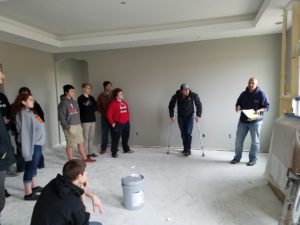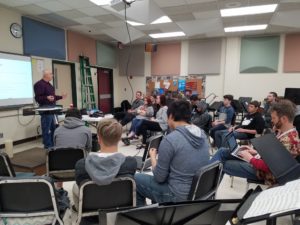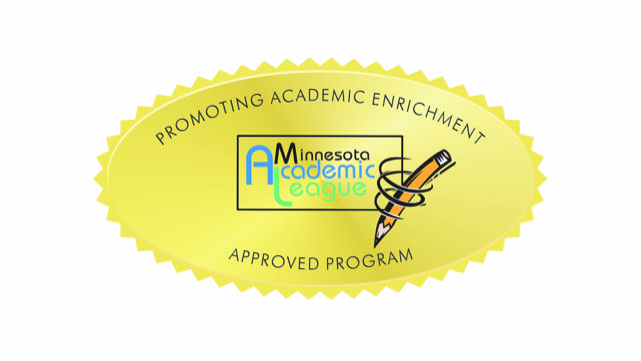By Southern MN YES! Coordinator Michelle Isaacson
On the blustery Wednesday March 22, 2017, 14 students from Mankato West High School and New Prague Alternative Learning Center gathered at Mankato West High School to attend the Gaining Energy Skills Winter Workshop. Students spent the day learning about energy efficiency of buildings.
The day started with a survey to see how much the students already knew about energy efficiency. Questions such as “what is the most cost effective way to save energy,” and “which type of light bulb uses the most electricity” were some of the measures for the participants’ background knowledge. The group then went throu gh the correct an swers with short explanations from presenter Paul Schollmeier. Paul, a BPI (Building Performance Institute) Building Analyst, Green Home Institute Green Home Rater, DOE Home Energy Score Assessor, and an NRPP (Nation Radon Proficiency Program) certified Radon Technician, began his presentation on how to conduct an energy audit. He stressed the importance of safety checks, including making sure the house does not contain vermiculite and that all combustion appliances are turned off when conducting a blower door test. Participants even got the chance to conduct this type of test at the workshop.
swers with short explanations from presenter Paul Schollmeier. Paul, a BPI (Building Performance Institute) Building Analyst, Green Home Institute Green Home Rater, DOE Home Energy Score Assessor, and an NRPP (Nation Radon Proficiency Program) certified Radon Technician, began his presentation on how to conduct an energy audit. He stressed the importance of safety checks, including making sure the house does not contain vermiculite and that all combustion appliances are turned off when conducting a blower door test. Participants even got the chance to conduct this type of test at the workshop.
The blower door test simulates a 20mph wind blowing over the roof of a house so the fan was set to suck  air into the room through any cracks or poorly insulated areas. Students used infrared cameras to find locations where there were cold spots. This method works best in winter when the air outside is much colder than inside, showing a greater temperature difference at leaking locations. Using a special type of smoke stick can also work for finding leaky areas if an infrared camera is unavailable. Participants learned that power outlets are places that air can seep into, as insulation around those locations tends to be insufficient. Putting a gasket behind the outlet plate can remedy the issue. Students saw that outside facing corners and windows were places that were commonly not properly sealed or insulated.
air into the room through any cracks or poorly insulated areas. Students used infrared cameras to find locations where there were cold spots. This method works best in winter when the air outside is much colder than inside, showing a greater temperature difference at leaking locations. Using a special type of smoke stick can also work for finding leaky areas if an infrared camera is unavailable. Participants learned that power outlets are places that air can seep into, as insulation around those locations tends to be insufficient. Putting a gasket behind the outlet plate can remedy the issue. Students saw that outside facing corners and windows were places that were commonly not properly sealed or insulated.
Paul also talked about his home as it has been transformed into an energy efficiency hub. On the property are many passive and active energy strategies including solar panels, rain gardens, and a double in their insulation R-value. Each year they use around 3,500 kWh while the typical home uses almost 10,000kWh. They even produce 5 to 6kWh more than they use each year so they are able to sell that to the power company and be paid for it!
Participants wrapped up the morning with a tasty lunch at school before heading off for a tour. John Hoffman, Project Manager, and Elijah Kannmacher, Project Coordinator, of Wilcon Construction met us at one of the company’s building sites. They talked about what aspects of construction assist in energy efficiency of a home and students were able to see two houses at different stages of assembly. One house was still under construction with walls freshly painted while the other was fully furnished to give potential buyers a look into how the house would be when they move in, as it was ready to sell. Wilcon houses have insulation around the foundation from the footing to the frame. They also put poly sheeting around it to further create a barrier, causing the thermal break to happen outside instead of inside the house. On the inside of the house, the stud spacing is 24 on center instead of 16 on center, meaning there are larger gaps between studs allowing for more insulation. Windows were purchased locally from North Mankato and are dual pane. The houses we visited had radiant tubing in the floor as a heat source as it is a highly efficient way to heat the house. They also use High Efficiency appliances that are properly sized to the house. An air conditioner that is too big for a house, for example, will cool the air too fast to get the humidity out of the air causing condensation and eventually mold, so proper appliance sizing is extremely important. Other features of the homes included low flow plumbing, programmable thermostats, all lighting being CFL or LED, low volatile organic compound (VOC) paints, recycling centers in the kitchen, centrally located mechanical rooms and more. All of these aspects contribute to a higher energy efficiency of the houses.
Even though the day was windy and cold, students were highly engaged and came away with an extended knowledge of energy efficiency and ways to make their own homes more energy efficient.
